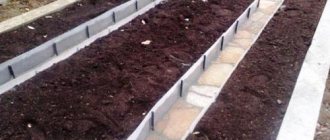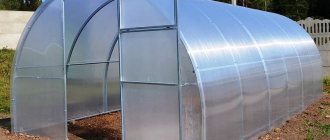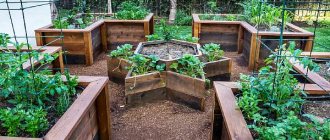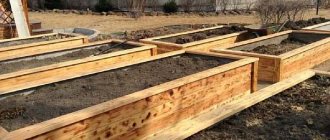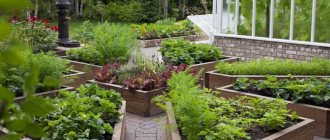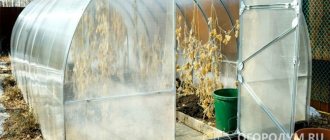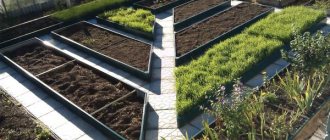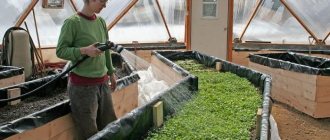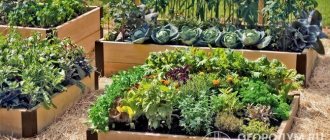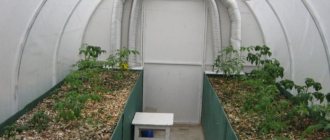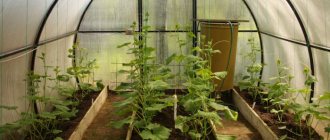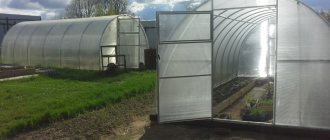The planting option proposed by Kurdyumov guarantees a decent harvest both in cold and damp regions and in the dry southern regions. And all due to the fact that the beds are “raised” and filled in a special way. Or, conversely, they are “lowered” into a trench.
And such beds of Kurdyumov have a lot of advantages that are not characteristic of traditional garden plantings. The method is suitable for any climate, site topography and type of soil. And therefore it is very popular among summer residents.
Nikolai Ivanovich Kurdyumov - agronomist, author of the books “Smart Garden in Details”, “Smart Vegetable Garden in Details”, “Smart Vineyard”, “Smart Melon Plant”, “Mastery of Fertility”, “Smart Garden in a New Way”, etc. Born in 1960 year in Adler, lives in the Krasnodar region. Graduated from the Timiryazev Moscow Agricultural Academy. In his books he skillfully combines theory with practice. He is passionate about organic farming and shares techniques for increasing yield without the use of fertilizers and stimulants. As a writer, he was awarded a gold medal at the Third International Exhibition “Golden Bunch of Grapes 2001”.
- Legendary gardeners: 15 people who created modern agriculture
There seems to be nothing new in gardening these days. But was it always like this, and what could the pioneers say about it?
What are the features of Kurdyumov’s beds
Kurdyumov's beds are long, deep and narrow boxes or trenches that are filled with branches, twigs, trimmings, half-rotten organic matter, and covered with a layer of ordinary garden soil on top.
By placing compost in the bottom layer of boxes or trenches as it rots, the temperature rises, but due to the top layer of soil it does not go into the bed. The peculiarity is that Kurdyumov’s “smart” beds heat themselves.
And with the constant decomposition of organic matter, under the influence of microorganisms and worms, the composition and structure of the soil becomes more loose and nutritious. Compared to conventional beds, there is no depletion or depletion of the soil.
Kurdyumov's warm beds are built on the principle of a layer cake. Regardless of whether they rise above the ground or are lowered into a trench.
This arrangement of soil layers makes it possible to use the site without digging and fertilizing for four to five years.
Operating principle
Organic heat released in the middle layers during the gradual decomposition of organic matter by microorganisms allows the summer season to open a month earlier without fear of spring frosts. At this time, your neighbors in the area will still be actively clearing snow from the area. The surface film or lutrasil will retain the heat coming from the ground, thereby creating its own special unique microclimate above the surface.
In the first year after creation, do not plant dill, parsley, spinach, radishes, onions, garlic and other plants that accumulate nitrates on the Kurdyumov beds, since the beds during this period contain excess nitrogen. Better plant tomatoes on them. cucumbers, eggplants, peppers, squash, zucchini. In a year, it will be possible to plant cabbage, celery, and lettuce on them.
Kurdyumovsky beds are 100% organic farming without any chemicals, which does not deplete, but rather improves soil fertility year after year.
© Ilya Vladimirovich | 2017-05-19 That same gardener
Advantages and disadvantages of Kurdyumov's beds
Such warm beds have many advantages:
- they warm up faster than other beds, which means you can sow seeds and plant seedlings 2-3 weeks earlier;
- the delicate root system is well protected from freezing due to internal heat;
- plants do not need to be fed with mineral fertilizers - the compost in the lower layers nourishes the plantings;
- narrow beds are well ventilated, so crops are less likely to suffer from diseases whose pathogens actively reproduce in a humid environment;
- you don't need a lot of nutritious soil. This is especially important in areas with rocky or heavy clay soils;
- such a garden does not need to be dug up every year;
- crops do not spread throughout the entire area;
- It is easier to care for such beds.
Disadvantages of structures:
- beds in boxes dry out quickly, so they must either be located next to a water source or have drip irrigation;
- considerable costs for the construction of beds - you will need both materials and time for construction.
Covering material
Vegetable growers often cover the bottom of the bed with geotextiles, and they also mulch the paths. Geotextiles are a universal material. It protects the beds from weeds, allows water to pass through well, but at the same time prevents soil from being washed away. The material is used depending on its density. The strongest, silver geotextiles (sold in hardware stores) are used as drainage material. For other gardening work, for example, covering beds, users of our portal recommend choosing black and white.
alisa FORUMHOUSE user
Lasts a very long time. It doesn't tear with your hands. The labor intensity of caring for such a bed is reduced many times over. Although perhaps this is for the lazy.
This is not to say that by covering the base of the bed with geotextiles, you will say goodbye to weeds forever. But “pulling out one weed exhausted by the struggle for rooting” is much easier than constantly bending your back weeding. Having done everything correctly once, then all that remains is to maintain order.
The height of the bed on top of the geotextile depends on the size of the plant's root system. It can be 30 centimeters for an “ordinary greenfinch”, and half a meter for something larger. In general, it is recommended to immediately make a bed 50-60 centimeters thick.
How to make Kurdyumov's beds
Kurdyumov's beds are usually built in two types - in boxes and trenches. The former are good in regions with a damp or cold climate, the latter in hot and dry areas.
For box beds, special wooden boxes are built with a width of 50 cm and a height of 30 to 60 cm. If there are no high-quality boards at hand, then you can build boxes from slabs, slate, galvanized metal, etc.
- 11 options for raised beds
An overview of all the different options for raised beds.
For trench beds, ditches are dug 30-40 cm deep and 60 cm wide. Their length depends on the area of the plot and the material capabilities of the gardener.
The wooden frame for the classic box beds according to Kurdyumov is made from beams and thick planed boards (20-50 mm) of coniferous trees.
Before installing beds from Kurdyumov boards, level the area. Clear the area where the structure will be located of stones and plant debris.
Lumber for the frame can be treated with a special protective compound.
- How long do wooden beds last and how to extend their life?
Neat wooden beds are a decoration for the site. We will tell you how and with what to treat wood so that it lasts longer.
Dig support posts into the ground - at the corners of the future box and every 60 cm along the sides.
Attach the boards to them from the outside with self-tapping screws to the desired height. Press the bottom row of boards lightly into the ground.
Make sure that the structure is not bent.
The length of the box can be reinforced with transverse stiffeners.
- How to make raised beds at your dacha with your own hands (photo, video)
Build a raised bed in your garden – it’s not difficult at all!
The benefits of mulching
Mulch is any material lying on the surface of the soil and shading it from the sun.
To create a mulch layer, use: A thick layer of mulch solves several problems for the gardener at once: Kurdyumov considers the most useful mulch to be the one that contains a lot of carbon - wood chips, tree branches, leaves.
It is advisable to grind large particles using a special device - a garden shredder. It creates an optimal fraction - the mulch does not cake and does not dry out.
Layout of beds
According to Kurdyumov, the garden should be well lit, so choose a sunny place.
The long side of the bed is usually oriented from north to south.
Since the beds need watering, place them near a water source or consider the possibility of organizing drip irrigation.
The ideal distance between the box beds is 70-90 cm. This will allow you to walk freely, carry equipment and care for the plantings.
Mulch the plantings in the beds with sawdust, dry grass or agrofibre, and mow the passages between them, cover them with straw, gravel, boards or even paving slabs.
We sow green manure
Kurdyumov repeatedly noticed that bare soil, devoid of a plant “blanket,” quickly loses its structure and fertile layer.
In nature, bare soil does not exist; it is quickly covered with vegetation. Nikolai Ivanovich suggests doing the same thing: after harvesting an early harvest, sow fast-growing crops and prune them without waiting for flowering and seed formation. Thus, three problems are solved: Fast-growing cereals and herbs are used for green manure. Of these, the popular ones are:
Before sowing green manure, it is necessary to take into account some subtleties.
For example, after harvesting cruciferous crops, you cannot sow radish and mustard, since they also belong to the cruciferous family. Even when sowing green manure, it is advisable to use crop rotation - do not sow crops of the same family for more than one year in the same bed.
They sow green manure thickly so that they stand like a wall and cover the entire ground. Before winter they are sown a little less often.
The lawn is also considered as a permanent green manure, suitable everywhere except in mulched beds and tree trunk circles of very young plants.
How to fill Kurdyumov's beds
The main feature of the arrangement of beds according to Kurdyumov is the clear order of layer-by-layer filling of the beds.
This arrangement of layers will make it possible to use the beds without digging and fertilizing for three to four, or even five years.
Box filling diagram:
- bottom layer (drainage): put some gravel, pebbles or broken bricks, and then branches of trees and shrubs after pruning, sawdust, corn and sunflower stalks, spill everything with water;
- second layer: place fallen leaves of fruit trees, aspen and birch, beet and carrot tops, cabbage leaves, potato and apple peelings, unripe compost in the box. Apply microbiological fertilizer (Baikal EM1, Siyanie, etc.). Pour water and sprinkle with a thin layer of soil;
- third layer: layer of mature humus;
- fourth, top layer: fertile garden soil. The layer should be about 15 cm thick.
Spray each layer with water and compact thoroughly. Well-trodden layers will not fall through and mix.
Fill trench beds in the same way.
It is better to fill the boxes in the fall, before the onset of frost. In the spring, as it thaws, organic matter will begin to decompose, the soil will warm up, which will create favorable conditions for seed germination and seedling growth.
Using Kurdyumov’s method, you can grow vegetables in greenhouses.
- What can and cannot be placed in high beds: instructions in pictures
How to fill a warm garden bed to double the harvest? We found out for ourselves – and we’ll tell you!
Four Conditions of Fertility
Kurdyumov considers four conditions of fertility to be the main components of his success:
Let's consider each of the conditions in more detail.
Optimal and stable humidity
Productive activity of microorganisms in the soil is possible only with normal humidity. In too dry soil, bacteria are suppressed, and the decomposition of organic matter practically stops. In waterlogged soil, instead of decomposition, harmful putrefactive processes begin. (see potato pancakes with minced meat - recipe).
Soil air permeability
Plants practically do not grow in soil that is too compacted.
If you dig, you won’t find worms and insects in it that process organic matter into humus. All processes in the soil occur thanks to oxygen - nitrification of nitrogen, dissolution of phosphorus and potassium with acids. Structured soil, rich in soil tubules, receives much more moisture than compacted soil. This process can be observed in the forest. Even after prolonged rains, there are almost no large number of small puddles. All moisture is absorbed deep into the ground.
In summer, the soil should not overheat
And ideally, it should be colder than the air, then internal dew will form on the walls of the soil channels, which regulates humidity. Sharp changes in day and night temperatures negatively affect the growth and development of plants.
Large amount of carbonic acid
The following biological chain can be traced here: soil with a high content of undecomposed organic matter attracts many insects and worms, which decompose organic substances into minerals (nitrogen, phosphorus, potassium and others) and release carbon dioxide.
The latter, combining with water in the presence of oxygen in the soil, forms carbonic acid, which can convert minerals into forms digestible by plants. Thus, the accumulation of humus occurs - the fertile layer of the earth. How to ensure that all of the above conditions are met?
Nikolai Ivanovich is confident that this can be easily achieved by performing the following agronomic techniques:
Kurdyumov describes in detail how to correctly carry out these techniques.
